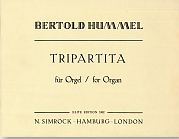Tripartita for Organ, op. 12 (1955)
I.
Ostinato
II.
Fantasia
First performance: July 13, 1957, Freiburg, Lutherkirche
Max Kempf

Duration: 11 Minutes
Publisher: N. Simrock Hamburg-London (Boosey & Hawkes) ISMN M-2211-1335-1| I. | II. | III. |
Errata: 1st
movement: quarter note = 152
Tripartita, op. 12 was written between 1st and 10th October, 1955. Three movements - schnell-langsam-schnell - , based on variable metre as a constructional principle. In the 1st movement, block-like structures dominate, arioso elements with short motifs dominate the 2nd movement. The almost completely unisono, toccata-like finale rounds the work off with a virtuoso flourish.
Bertold Hummel
Bertold Hummel
composed the Tripartita for Organ in
1955. It consists of three movements: Ostinato,
Fantasia and Toccata.
The first movement is based not only on a melodic motif,
developed out of a seminal cell of two notes and
constantly repeated, but also on a series of metrical
units, 3/4 - 5/4 - 7/4, which remain in this
order from beginning to end (double Ostinato).
In the Fantasia, the peaceful second
movement, three differently structured stanzas frame a
meditative melody.
The life in the virtuoso Toccata comes
from the rapid note repetitions, only performable on an
outstanding organ. Characteristic of this section are
the bar lengths, shortening and then lengthening
successively by one beat at a time - clearly audible in
the pedal motif.
Josef
Trompke
Larry D. Crummer: The Solo Organ Works by Bertold Hummel, Dissertation 1983
Press
Musik und
Kirche, Jan/Feb, 1958 Vol. 1
The very
compact "Tripartita" has a lively opening
with a harmonically-based idea, spread out syllabically,
interrupted by rests, over a markedly leading pedal. The
means of formal construction is the linear bass; this
adds to a triad motif further intervals, so that the
planned total range of intervals is achieved after
twenty-one bars. Boris Blacher's variable metre
technique comes to mind. The slow middle movement
consists of a combination of threefold thematic
material. If in the opening harmonic colour prevailed,
then it is now above all the sumptuously-delineated
melodic contour which dominates. With multifarious
substitutions and inversions, constantly new
perspectives of the same idea are revealed. The third
movement is conceived as fast passage-work with repeated
notes and octave displacements on the manuals,
maintained unisono throughout except for the close. This
new work is captivating in its unsulliedly fresh power
of invention. The formal principles are thoroughly
individual and use no worn-out standard patterns;
effects in sonority, sometimes extremely astringent, are
applied with such economy that one immediately believes
on first hearing in their musical necessity.
H.L. Schilling

